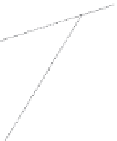Graphics Reference
In-Depth Information
Pattern
Complementary pattern
Object surface
Object surface
Light
source
Light
source
i
i
Camera
Camera
Pattern
Pattern
Figure 8.40
Image capture using binary checkerboard light patterns. Two images are captured, with
opposite squares of the checkerboard lit. (After [Nayar et al. 91].)
age in two ways: one accounting for only direct lighting, and another including
only indirect illumination. The reasoning was that having such images would be
extremely useful in verifying existing reflectance models and rendering methods,
and would also assist in creating new image-based techniques. Of course, the
separate computation of direct lighting and global illumination was not new in
computer graphics, but this separation in
captured
images showed the effects of
direct and global illumination in real scenes for the first time.
Nayar's method described in the paper works with images of a scene cap-
tured under complementary “high frequency” patterns of incident light, e.g., a
checkerboard pattern.
16
An image captured under such a pattern of light is said
to be “partially lit;” the light source is called a “partial source.” The basic pro-
cess uses two partially lit images. The first photograph (image 1) is captured
by placing a checkerboard filter between the light source and the scene (
Fig-
ure 8.40 (left)
). The second photograph (image 2) is captured with a checker-
board filter having the same frequency of squares, but with the dark and light
squares interchanged (
Figure 8.40 (right)
)
. In either image, light coming from
the unlit parts of the scene is entirely indirect. These unlit parts are complemen-
tary, so combining the unlit parts of the two images produces a complete image
containing only indirect lighting.
Of course, finding the unlit parts of a captured image is a difficult problem in
itself; doing it directly would require a precise geometric model of the scene, the
position of the camera, and the orientation of the checkerboard filter. The point is
that the two images contain the information needed for the separation of indirect
lighting. The actual separation method does not try to combine the images di-
rectly. Conceptually, the scene objects are split into hypothetical surface patches.
16
The “frequency” of the illumination is determined by the size of the checkerboard squares: the
finer the black and white checks, the higher the frequency. In this context “frequency” refers to
the illumination pattern, not the frequency of the light as an electromagnetic wave.


































































